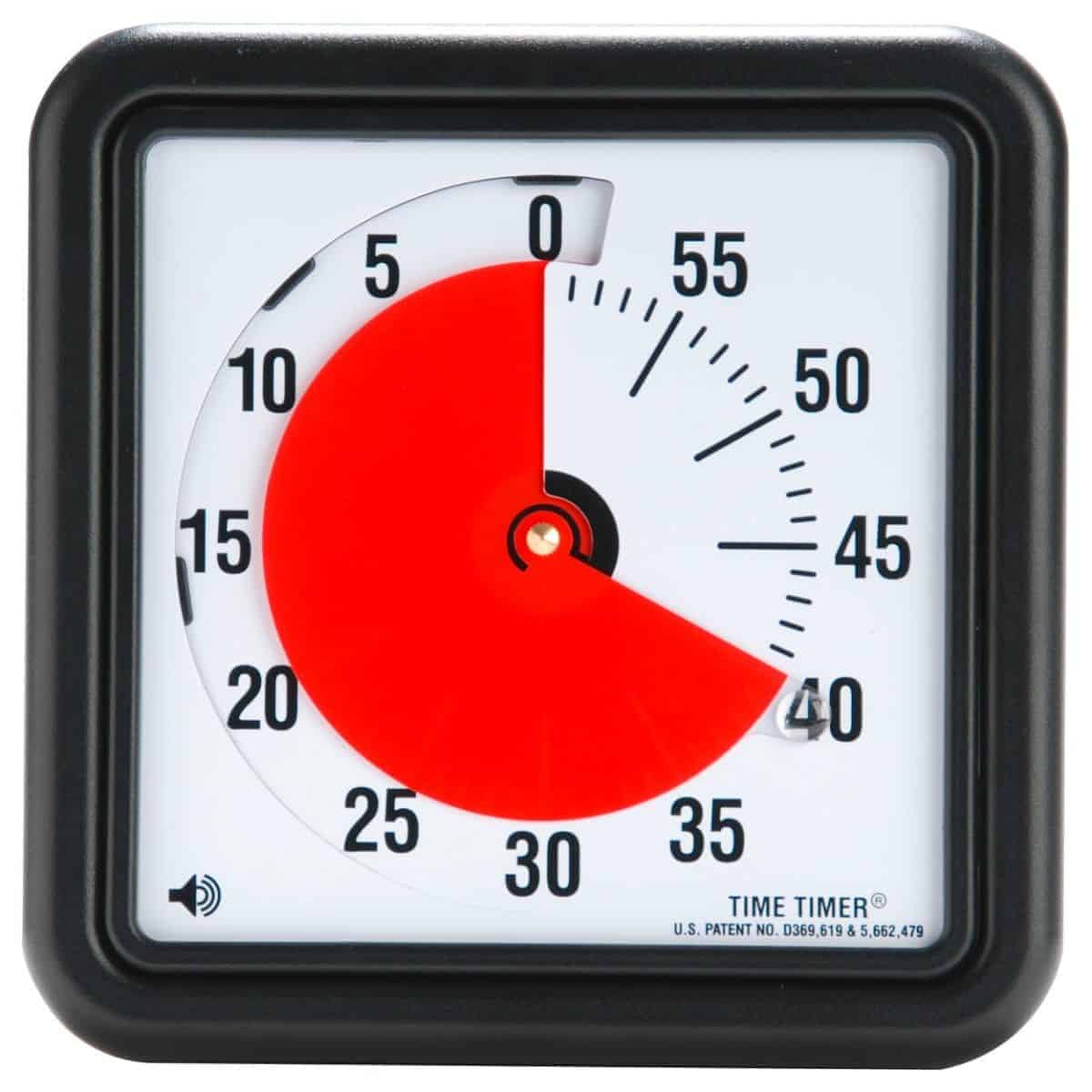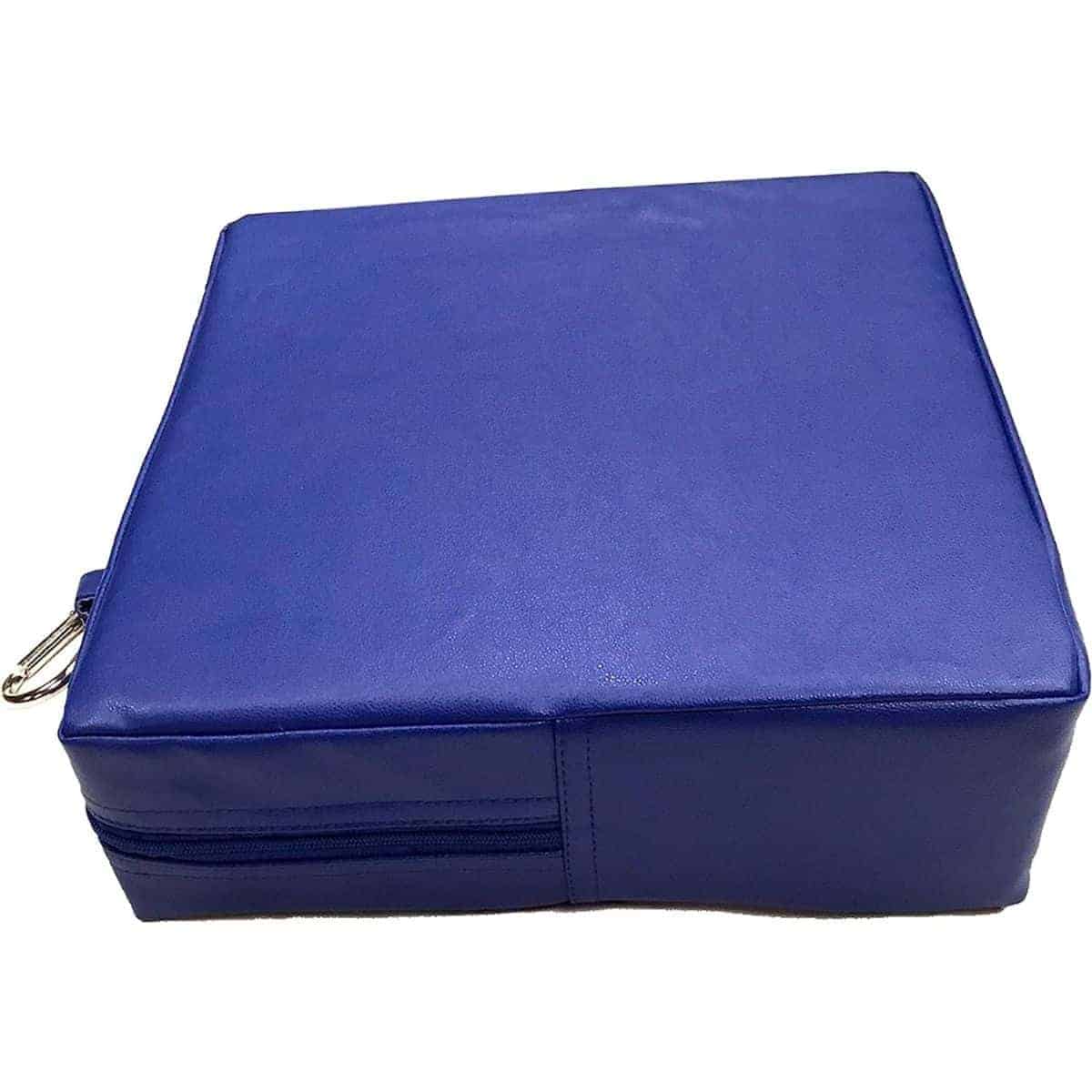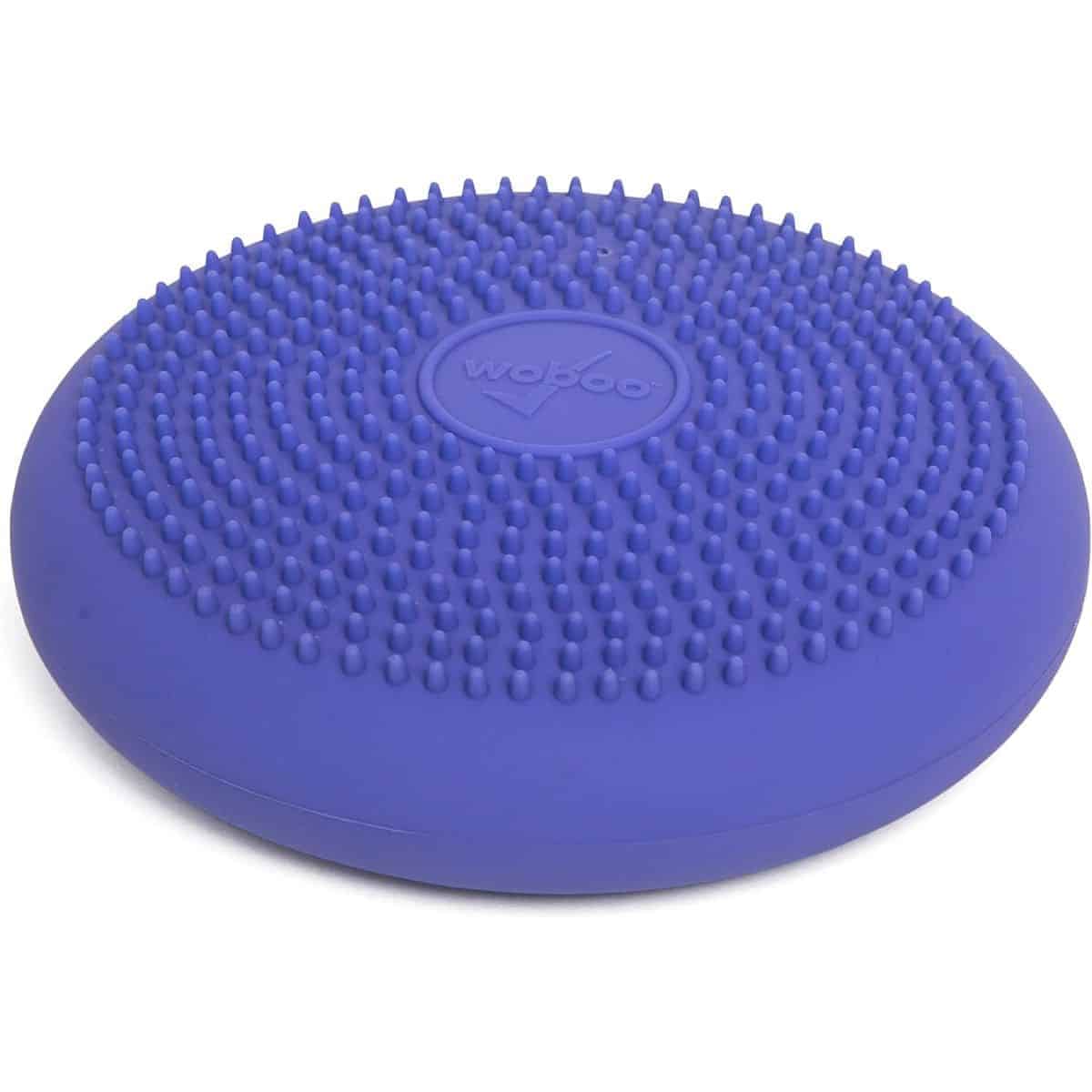Learn how to get your child to sit still for dinner, lunch, or any meal whether they’re 2, 3, 4, 5, or 6+ years old with these tricks from an occupational therapist!
Affiliate links used below. See our full disclosure.
Do you have a kiddo that flees the dinner table a few minutes into the meal or is so fidgety while sitting at the table they can barely eat?
It’s a question that comes up quite a bit around here, because I talk a lot about picky eating and sensory issues, which often make it hard for kids to sit still.
The good news, that even for the most fidgety or picky kids, there is a lot you can do to help them sit down and eat a meal without getting up 100 times!
In fact, I’m going to share 8 ways you can help your child sit still to eat at dinner, lunch, breakfast, or even snack time.
I’ve been there as a mom with my three kids, but have helped hundreds as a pediatric occupational therapist.
And, if you’ve got a toddler, I’ve got some special tips for helping them sit still long enough to eat!
This article is jam packed with tips and tricks – make sure you pin it so you can find it again quick!
And look for the FREE Printable with all 8 ways to help kids sit still to eat at the end of the post!
Why is Sitting at the Table to Eat Important?
First and foremost, when kids hop around, get up and down, or don’t sit at the proper position while they’re eating they’re at a greater likelihood for aspiration (food/drink getting in their lungs) or choking.
But, beyond that there are countless studies that show the benefit of kids eating together at a table with their family. Everything from higher IQ to lower risk mental health diagnoses in the teen years.
And, as my Mealtime Works students know, it’s a key step in helping picky eaters eat new foods. Think about it… if your kid won’t sit still at the table, how will they be able to try a new or different food?
Eating a meal at the table also creates a routine for your child so they begin to expect where and when they’ll eat. This can build positive associations with hunger and independence in self-feeding.
You could say eating at the table is a huge foundation for healthy eating habits! Read more about how to serve food to picky eaters.

8 Ways to Help Your Child Sit Still to Eat the Whole Meal
All of these strategies work together, and the more you’re able to use the more likely your child will sit still for dinner! Of course, don’t expect perfection, it probably won’t happen. Instead look for small signs of progress.
Maybe your child only sits at the table for a total of 3 minutes right now before they get up. It would be great progress if they manage to sit for 5 whole minutes.
As you consistently use the strategies below the length of time will likely increase too!
- Feed your child on a schedule – Spacing your child’s meals 2.5 – 3 hours apart with no snacking in between but water is key.
If your child isn’t hungry when they get to the table it will be incredibly hard to get them to sit still.
Getting into a routine of nothing but water in between these meals, means your kid comes to the table HUNGRY and will be far more likely to sit still!
- Have everything ready before you bring your kid to the table – This can be challenging, especially with multiple kids, I know from the daily experience in my home.
But, having everything ready when your child comes to the table so that you can both sit down together will help ward off them hopping down or complaining before you even get to the table because you’re still pulling a side dish out of the oven.
You will be able to redirect your child and actually start eating the meal when everything you need is all set up.
- Keep meals between 10-30 minutes max – While some kids play around or are very distracted when they eat, it is still important to keep meals to 30 minutes or under.
It’s hard for kids to sit still for long periods of time, and they’re eating at the table at least 3 times a day. Expecting them to sit still at the table for longer than 30 minutes won’t be effective.
If your child isn’t able to sit for 10 minutes this is a great goal to start with, ultimately working your way towards 30 minutes for family dinners or meals.
Some kids really benefit from a visual or sand timer as you’re working on increasing the time at the table. This way they can see how long they need to sit at the table. , one that they can. I’ve used this visual timer many times with kids. It’s perfect for kids that like visuals, toddlers, or kids that don’t know how to tell time yet.

- Make sure they are seated well – It’s important that your child is in the proper position for eating. A chair that’s too big will cause even the calmest of kids to turn wiggly.
If your child can’t reach the table while seated comfortably, then their seating will need adjusted with a booster seat or different type of chair.
You want to make sure they can sit firmly on their butt and have their elbows above the table. Having something under their feet so they aren’t dangling would be ideal.
Check out more in the Best Position for Kids to Eat Meals.
- Offer sensory activities before the meal begins – Even if your child doesn’t have sensory “needs,” sensory activities can calm and organize your child’s brain so they’re able to sit still to eat.
There are tons of sensory activities, but movement based ones that involve proprioception are my go to.
However, if you don’t see your child responding after multiple days of trying, then you may want to experiment with more gentler sensory activities like playing in sensory bins or listening to music.
If you want to learn more about how sensory activities can be used to help calm and regulate kids, grab a seat in our free workshop!
- Use a starting cue – A lot of times, a child wants to leave the table so soon because they aren’t used to the routine yet. If you suspect this is the case in your home, it would be helpful to consistently use a prayer, song, or music to start a meal.
Your child will begin to understand that when they hear the cue that its time to sit and eat. You can also have your child set the table, to anticipate and signal the meal is about to start
Of course, make sure there are no other distractions tempting them away from the table. Turn off the tv, put toys out of sight, and even close the blinds, if you need to!
- Give sensory input during the meal – Besides using sensory activities before the meal, you can also use them during the meal! These are some of my favorite sensory toys that continue to support kids sensory needs while they eat:
-
- The Senseez Pillow – A pillow that vibrates when you sit on it. If you stand up the vibration stops. Vibration is an extremely powerful and calming form of sensory input. This is an easy fix, and it adds extra motivation to come to the table in the first place because it is so much fun. You snag one for yourself here.

-
- Weighted Lap Pad – This pillow goes on top of the lap and is heavy. You can either take a large tube sock and fill it with beans or rice, tying a rubber band on the top. Or, sew a simple small pillow just about the size of your child’s lap and fill it with beans or rice.
Not the DIY type, get a ready made weighted lap pad here.

-
- Wobble Cushion – This simple inflated pillow is often textured and allows just enough movement to help kids get their wiggles out and is a fun way to move, but not so much that it’s distracting.
You can get one here.

You can use either of these tools on their own or together!
- Be consistent and persistent – It might be challenging in the beginning as you start to implement these changes in your home. Remember, making a good eating habit takes time.
It will be tempting to throw in the towel if your child continues to get up from the table often, but I can tell you, as I’ve seen so many times in working with kids, whether they are younger children, older kids, or teens, that with using these steps, the more persistent and consistent you are, the quicker you will see success.
Establishing any new routines to bring change is hard, but worth it!
What to Avoid When Trying to Help Kids Sit Still at Dinner
There are a couple of pitfalls that parents often understandably fall into when trying to get their kid to sit at the table…
- First, is using distractions at the table like tablets, phones, books, toys, TV, etc. I totally get why this happens, so no judgement at all, but it is really important to phase them out because they can lead to unhealthy eating habits. I have an entire post dedicated to distractions at the table, read it here.
- Second, avoid power struggles. If your child is throwing down the gauntlet and they aren’t coming to the table, don’t engage with them. If they’re having a tantrum, help them go to another room where they aren’t disturbing anyone else’s meal. This can be hard with young children, but it’s important.
Let them know that they can come to the table when they are calm. If they don’t calm down or flat out refuse, tell them that coming to the table isn’t negotiable and if they refuse, there won’t be any food until their next meal (which should be only 2.5 hours away).
Have them repeat this back to you, so you know they understand. When they are calmed down at some point later, take some time to talk to them about this. It might help to let them choose something benign like which chair they are going to sit in or which plate they’d like to use.
This will give them a sense of control. Don’t allow them to choose the food for the meal, that’s a bigger decision that they shouldn’t have control over. Read more on the division of responsibility, which is the an outline of your role at meals and your child’s.
The Toddler that Won’t Sit Still to Eat…
While all 8 of the tips are great for toddlers too, there are two other important points to keep in mind when dealing with the 1-3 year old crowd:
- Toddlers are notoriously difficult to keep seated at the table. The younger they are in this range the more challenging it will likely be. 1 year olds will be harder than a 3 year old, but practicing early helps.
A lot of this has to do with the developmental phase they are in, it’s frustrating, but its normal and it will pass if you stay consistent with your routine. Try, as difficult as it is, to be patient with them, and yourself!
- I highly recommend that you keep toddlers in a high chair or booster seat with a strap on it until they are 3. This includes a foot rest or foot support so they are in a comfortable position.
Use the strap at every single meal! Once you open the door to a strap free life it can be difficult to un-do with little kids, but not impossible. Slowly reintroduce, and, again, be consistent. That strap will save you tons of battles!
Get the Free Printable
Want to make sure you remember all 8 strategies for getting your kid to sit still to eat? We’ve got you covered.
Click here to download a free printable that includes it all.
Save it to your phone or hang it on your fridge for a quick reference!
More on Help For Getting Kids to Sit Still to Eat
Create a Sensory Diet with this Template: Free PDF
5 Quick Tricks for the Toddler that Won’t Eat Dinner
5 Top Wobble Cushions for Kids Focus & Core Strength
Alisha Grogan is a licensed occupational therapist and founder of Your Kid’s Table. She has over 19 years experience with expertise in sensory processing and feeding development in babies, toddlers, and children. Alisha also has 3 boys of her own at home. Learn more about her here.



My 3 year old son just doesn’t like eating food/trying new things. He just loves eating plain ghee roti without vegetables. Also he will eat of and only if i feed him. I have to hide sabji deep inside roti byte and show him mobile.
How can I make him eat himself and try every food served to him
Additionally he also spits out every first byte that i feed him and then after few trials with help of screen he starts eating
Hi Sayali! So sorry to hear that mealtime is difficult for you and your child. You are not alone! The first step in working on any picky eating is starting with a no pressure environment! Try serving the same meal for everyone, along with something that he likes, but don’t put any pressure on him to eat anything. A no pressure environment can really help kids feel more comfortable around mealtimes! Allow him to touch/feel/play with his food and practice with utensils and feeding himself. Since he spits food out frequently, try using a toothbrush to brush the insides of his mouth before mealtimes. This will help desensitize his gag reflex and strengthen his oral muscles. We have more tips here!
Best,
Kalyn
My son is 6.5 years now. He eats everything but only when I feed him. If he is left alone to eat by himself he takes almost upto an hour. And in this time I have to keep telling him , eat your food , take the next bite and it’s getting late finish your food. And among all this I loose temper and shout at him or go and feed him myself. He is a darling boy otherwise, only food is our problem.
He is not a good eater .. but by now we both have figured it out what he likes and what’s important to eat. So he almost eat everything but the meal times are very long and need constant reminders from me to have the next bite or finish the food.
Kindly suggest something to help.
Hi Himani! Thanks for reaching out! Try to avoid force or pressure at mealtime. The less you stress about his eating, the more comfortable he will be to actually eat his food at mealtime. Try to have everyone sit together at the table to eat, this way he doesnt feel secluded and can see everyone else eating, and therefore, want to eat too. You may also try to minimize distractions during mealtime, like turning off tv and other electronics. Hope that helps!
Best,
Kalyn
My daughter is 2 and 2 months. She has always been an excellent eater until recent months. She started to refuse her high chair, so I gave her booster with straps. This on lasted for about 2 months. She would asked to unbuckle and leave the table. If I refuse to unbuckle, she would cry…..
I recently bought a cushion for her. She sat there for a week then again tries to get jump off.
Weird enough, when we eat out, she sits in the booster chair with no problem and she stays there for 20-30min & finishes all her food.
Thank You,
Hi Thanks for reaching out! I’d make sure that you do have the proper seating position! While she may be sitting in the new seat, because it is new and exciting, she may need some more support. Making sure they have something to place their feet on and sitting in a 90/90/90 angle is very helpful. Also, getting in some sensory input prior to meals can be helpful. Check out our post on Proper Positioning for some more tips!
Best,
Desiree
Hi, i have a 18months old son, I can’t make him sit still when comes to meal time, i use high chair with strap, comfy chair and foot rest. When it comes to meal time, he can only sit still for 5min and then ask me to help him get off from the chair and started running around the house, so i fed him while he spinning around the house. Should i stop feed him by the time he ask to get down from the chair? If I’m doing that, I’m worried that he only got a small amount of food and asking for a milk in a couple hours after that. Because the lunch time is at 12pm and nap time is at 2pm, so by the time he ask to get down from the chair, i don’t have any time to wait 2-3 hours to fed him again because it’s nap time. If i refuse to help him to get down from the chair, he will start to screaming and get angry (tantrum) really bad.
Hi Jeane,
Thanks for reaching out to us! I’d work on trying to do some proprioceptive activities prior to mealtimes. Some kids just need to get all of that input from the activities to be able to sit for longer periods of time. You will have to do some trials to see what activities may work for your son, but hopefully find some that will increase ability to sit for longer period of time. You can check out some proprioceptive activities here
Best,
Desiree
Hi, I have a grandson who is 5 and in kindergarten this year. He is having a very hard time sitting still at lunch time. The monitor is stating he ends up crawling under the table. He eats a little but does not finish his meal. He can’t sit still. Ends up disturbing his classmates. Any advice.
Hey Sharon,
Thanks for reaching out! He may be trying to get his movement in at lunchtime since he’s needing to sit still for his other classes. I’d try talking with the teacher to see if there are other movement activities he can be involved in during class in the morning to “get it all out” so that he’s able to sit for his lunch times. We do have an article on Movement breaks for home or school you can check it out for some ideas!
Best,
Desiree
Hi, could you describe how to work up to a child sitting longer? Do I increase how long they sit by one minute? What if they are fighting to leave?
Hey Catherine,
Yes, I’d try to increase it by a minute slowly to increase the length of time that they are sitting. If they are having difficulties I’d make sure to look at their seating for proper support as well as providing sensory input before meals.
Best,
Desiree
Hi,
I have a 4 year old boy and he just cannot sit still to eat. We all sit together to eat and every meal is the same. He cannot sit still, he constantly has to be moving round. He can sit for over an hour and not eat. Should I be saying right that’s it until your next meal or should I make him sit until its all gone. He is naturally slim and I’m worried that the latter option will mean he eats less and I don’t want that!
Hey Megan,
I’d work on trying to provide some proprioceptive activities prior to meals (it may take some trial and error to find which activity will work best for him). But then also looking at seating and possibly a wiggle seat as suggested in the article so that he can still be moving while remaining seated!
Best,
Desiree
My 18 months old daughter does not want to seat on her high chair. Or she just wants one or two bites then asks to get off the chair. I try to make it seems like when she’s out of her chair the meal is over. Means that she will go to bed with empty stomach and wake up at 1am crying because she’s hungry. What should I do?
Hey Kay,
I’d be looking at each of the suggestions from the post. Making sure she is seated properly and providing sensory input during/before meals can be huge ones that affect sitting during meals.
Best,
Desiree
Hi! I have an eleven month old son who isn’t eating at all if he isn’t playing and won’t focus at all on food even if I give it to him to play. As well he wont sit ever while we are having dinner. We are desperate and dont know what to do because we tried everything and he wont sit in his feeding chair. What do you suggest? Is it too early to start teaching him to sit or I am even late?
Hi Kay, at 11 months old this is extremely common. The amount of time a child this age can be expected to sit at the table is quite short. The key is repetition and setting an expectation that meals will occur in the highchair/at the table but there is a lot of room for flexibility at this age. We recommend starting at the table and allowing breaks if need be to wiggle, play, etc. If he’s not in a high chair already, we really recommend using this even if he puts up a fuss at first, along with using a schedule that ensures he is hungry. But it will likely take time to build up tolerance, so even in 1 minute increments to build his stamina can really help.
Best,
Laura
Your Kid’s Table team member
We are doing all the strategies we can (meal time schedule, correct positioning, calming activities before meals, hand washing) but sometimes our 16 month old will not stay seated! After he gets down he will happily open his mouth and comes over to take food offered on a spoon – he can eat the whole meal this way. I know I’m probably perpetuating this behaviour but when I refrained he simply skipped meals and began looking v skinny! What can I do?
Hey Polly,
Great work at implementing the tips for schedule, positioning and calming activities. I’d try to take a look at making sure there is no pressure sneaking in at the table for him to eat. This can be in your mindset as well that he can feel as pressure!
Best,
Desiree
Thanks for the reply! I’ve found that since not worrying about his eating it has definitely improved (and I’ve been much happier too!) so I don’t think it’s that. I’m just wondering if I should be feeding him on the floor at all or can it only make it worse?
If you need to have some special breaks/days where you are breaking up the routine, this is okay. I’d try to not make it a habit for every meal!
Best,
Desiree
Hi, for those really active toddlers, with short attention spans, what do you think of allowing movement during a meal? Or letting them stand to eat?
Hey Catherine,
While everyone is different, we do recommend the sitting position in 90/90/90 positioning for meals making sure the child has a place to rest their feet. I’d try to do some deep pressure activities to promote calming prior to the meal to help get through the meal. You can find some great Proprioceptive Activities Here
Best,
Desiree
I have always struggled to keep my son seated at the table. He is no longer a toddler now. I like the idea of the meal is over once he leaves the table, but he is impulsive and I worry I would be punishing him for something he can’t control. What do you think?
Hey Catherine,
I’d still try the proprioceptive activities prior to mealtimes to see if that will help with him being able to sit for longer periods of time. You can start to go over the rules for him as well and it may take a little for him to know once he leaves the meal is over, but you can see how it goes. But always, go with what you feel is best for your family.
Best,
Desiree
Hi-
My son is 2.5 and we have been trying for over a year to get him to try a new food. We give him the preferred foods (which are few, but healthy) along with new things. We have exposed him to the same “new” foods many times, did all the tricks and gimmicks, and he just will not try anything. It’s hard to feed him away from home, so it feels like being a hostage when I know I’m not going to be able to give him a proper meal away from home because it can’t be replicated in a restaurant (he’ll eat a quesadilla at home, but not a similar one at a restaurant). We end up having to carefully plan everything around when he eats. It’s killing me. He won’t even eat a PB&J. We have had an OT come by for a few months, but he made zero progress. We were basically just told that it will take many tries of him seeing the same things over and over before he tries it. Any new advice? Thanks.
Hey Julie,
You are doing great at providing a preferred food with the new food! I would really work on trying to set up a no pressure environment. I’m not sure if you have seen our free workshop for picky eating yet, but if you haven’t this would be a really good resource for you, and walks you through no pressure environment. It will provide tips for how to set up mealtimes and schedule it. Offering of foods, etc. You can save your seat HERE
Best,
Desiree
Hi Alisha, thanks for all the helpful info. I love your site! I have a 19 month old who stopped eating 3 months ago. I am generally very disciplined with mealtimes but in retrospect have definitely made some mistakes (allowing toys, separate mealtimes etc.) which I am working on rectifying. I agree completely with creating a calm and positive environment which is why I don’t know what to do when my son won’t sit in his chair. He literally kicks and screams sometimes when I try put him in his high chair. Should I abort mealtime entirely when this happens? I am still breastfeeding so most of the time he refuses food because he wants milk. I often just give in because I know he is so hungry and milk is better than nothing but I know I’m making it worse long-term. Would really appreciate some advice on how to handle this. Thank you!
Happy to hear that you enjoy the site! It sounds like you are on the right track in identifying things that you are going to try to work on to get a more positive mealtime. After doing so, I’d recommend to try to follow through with these 8 steps in the article, providing a schedule, being consistent, sensory input, etc. But also take a look at the what NOT to do section, in particular power struggles, as it may help with some tips you may want to try!!
I have 18 month old twins. While they are both extremely good eaters recently one of them will not eat in his high chair. He starts to cry and throw food in floor. We take food away and say finished when they through food in general. But I know he is hungry and he signs more and food. I should say that this has just started and he only does it with my husband and I. He is fine at daycare eating and fine with the au pair during the week. It is with us on the weekend where he wants to sit in our lap and eat. We dont let him do this and he crys and has a tantrum. I am at a loss as to what to do. As I know he is hungry, but dont want to let him through food around either. Anyone have any suggestions?
Thanks for reaching out as I understand this can be tricky. It sounds like you are doing a good job with not letting him sit in your lap for meals. He may be craving some mom and dad time. I would try to provide some lap time/play time prior to meals to see if this helps. Also, I would still use the strategies as posted in the article, but make sure to read the what not to do section as well, with power struggles!!
Stay Consistent and keep us posted!
My 8 month old has recently started this – at every meal (except for breakfast) she would take 3-4 spoons of her food and then will not open her mouth no matter what I do. I, then have to distract her by giving her toys and while she is playing she will open her mouth. I know the toys distraction is not good. Any ideas what I am doing wrong and can do to make this better?
Hmm, it’s possible that she’s getting sick of baby foods, have you started table foods yet? If not, here’s a post to show you the steps to take: How to Transition your baby to table foods.
I witnessed a friend angrily tie his child in his seat with his belt. What do you think of that? He is not abusive in other ways.
I witnessed a friend angrily tie his child in his seat with his belt. What do you think of that? He is not abusive in other ways.
Yikes, that’s a bit of an awkward situation, I’d talk to him about it. I’d also keep your eyes out for other concerns and report accordingly. Parenting is so hard, and it may have been a weak moment, but it maybe a red flag.
My kids are 8, 9, 11 and they still don’t like to sit to eat. Well, the 8 yr old does the best because he is always hungry. Do these work for older kids as well? My kids do have sensory issues and have to keep moving. My husband says it’s ok if they need to get up and walk around during meals and he will also let them eat at anytime they are hungry, even if it’s right as we are going to bed. So if they don’t like something I make, they always know dad will get them something later. But I guess that is another subject! 🙂
Yes, these tips will work for them too! I like the idea of taking a short walk around the room if need be, if all other options have been used. I’d definitely try doing sensory activities before hand though and experiment to see what would work. Also, at their age, I’d ask them what they think would help, they just might surprise you!!
Fab article. My little girl has never been great at sitting at the table but recently this got a lot worse, we have stuck with it and enforced it only now she is having a ‘meltdown’ most mealtimes and it appears she is doing it so we will remove her from the table as she’s had enough of sitting there. Any advice?
Hai my Girl baby is 3 yrs old. She is not sewing food. Still taking smashes food only. Totally worried about her. Not eating properly.
I have a free picky eating workshop that I think would be really helpful for you. Check it out here. I think these are the first steps you need to take.
Hi I have three songs who are seeing an ot at the moment. Meal times are a disaster. One gets upset because he can hear his brothers eat. He cries and shouts at them to eat properly and sometimes plus a box in front of him so he doesn’t see them. Another just sits and won’t eat and every few minutes walks around the room. The other eats but can’t sit still. After every bite he walks around the room and sits for another bite and walks around again. He does this at school too.
Hi,
Thank you for your valuable information. My 3 year old son eats a lot of food and very good at eating at home on his small table. But, we go out for a restaurant it is very difficult to manage him. He doesn’t like the high chair in the restaurants and next thing we do is keeping some video and for some time he will be ok. But, after that he will stand on it or will come of the high chair / chair. Please suggest me.
Thank you so much.
It’s really hard at restaurants- at this age I didn’t take my kids often 🙂 But, I’d try to take a little walk with him or pack some other items to help occupy him- also restaurants that you know are quick!
Any thoughts for people who have no space for a dining table? The main floor of our house consists of a small galley kitchen, a tiny living room, and a half bath. My son is almost 3 and eats at his small toddler play table while we either sit on the floor next to him or on the couch. It wasn’t so bad when he was an infant, but it’s become an awful situation as he gets older. He’s incredibly picky and doesn’t sit for his meals. Are we scarring him for life?
Any table is fine Julie! You can use the coffee table and sit on the floor, pop up a card table, gather around he kid table… experiment and see what works for him. I do strongly believe in consistently eating at a table. This age is hard to keep them seated because of their attention span, but it will likely get easier soon!
Hi–thank you for doing what you do….when I stress or panic about sensory stuff or toddler eating I just go to your “articles” page that I have bookmarked and can usually locate an article on whatever I am struggling with! My questions today…
If my 3.5 year old is not done with his dinner when the timer goes off and he insists he is still hungry, do I take his food away anyway?
He also spills his milk/drink almost every meal due to squirming around so much. Tried a sippy cup but he really gets distracted by that. We typically have him clean it up but then he is distracted by that. Any other ideas besides the pillow?
Last question: he constantly is playing (scraping/banging) his fork on the table and throws a tantrum if we take it away and give him a baby fork made of plastic. I’m not sure how much of this to enforce… on one hand I want to just ignore it and let it go. On the other hand it’s hard to ignore because it’s gauging the table and super irritating for anyone at the table. Thoughts? Thanks for your time!
woah… definetly do not take your sons food away. i believe the timer is more to get them use to sitting down for longer periods of time. So they can get use to having ‘dinner time’ and that means we sit and eat.
and hes almost 3… id make him clean up the milk if he spills it. and just be consistent.
and the fork thing… okay i would hide all metal forks, spoon and knives. everyone uses a plastic. that is mom, dad, brother, sister. everyone. and if that isnt a option in your house…. then id cover my table with plastic table clothe and call it a day
good luck
Hi. I discovered your site today and trying to read and absorb every info that you wrote. I have a 21 month old who depends on breastfeeding and cowsmilk and maybe some piece of bread. Thats it. I m so disappointed each time ı try and feel like crying sometimes. What she does is to throw stuff including her plate off the table and not even taking a bite. She has never eaten any kunk food or processed things, doesnt know the taste of sugar. I have always given her whole foods. She used to est oatmeal at least but she is refusing it too. Do you think ı should quit gibing her cows milk and she d eat at some point? I reallyyy needhelp. Thanks
Hi Ishil, believe me, I understand where you are! There are a couple things I would start with and the first is getting on a schedule. I can’t tell you how important this is. You can read more about that here. I’d also really encourage you to take my picky eating workshop, its free and I think will be a really good starting point for you. You can sign up here. After taking a look at that first link let me know if you have more questions!
Hi,
What would you suggest when the tantrums/refusal to eat happens at dinner time and there wont be another meal happening until the morning? he may wake up hungry/crying during the night? would you recommend giving him a bottle if this happens?
My son is 18 months old.
Many thanks 🙂
Hi Sandra, at that age you’ll want to try and redirect him back to the table after a few minutes for sure. If it were me I’d also allow some crying at the table if need be just to help him get used to sitting there. This is another reason I love using the strapped seat, too. I try to redirect them and do something silly so its positive- if they’re out of control though you may need to give a few minutes and try a few times. Once he learns the drill, usually after a few days the battles really decrease a lot.
Thank you for this post. I’ve been doing all the wrong things. I will try all of these techniques. Hopefully something will trigger a change for my son.
Take your time! It can be really overwhelming for everyone if you change everything at once. Focus on one thing for a week or a few days and that add something else. I’m here if you need anything!